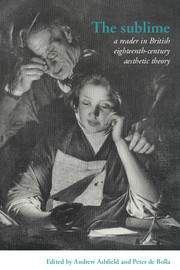Part IV - The Aberdonian Enlightenment
Published online by Cambridge University Press: 05 June 2012
Summary
Gerard's formation within the Aberdonian context of the Scottish enlightenment is clearly signalled in his interest in the category of ‘genius’, a popular topic for discussion in the Aberdonian Philosophical Society. But Gerard can also be read in the wider context of the British tradition in which analogues for the sublime are constantly sought. The gestures towards the Alps and the Nile, for example, can be found in the extract from Dennis in part I. The investigation of presence [Gerard] is also a topic for discussion in the Scottish school, finding its most sophisticated analysis in Kames's notion of ‘ideal presence’. Gerard mobilises a number of sub categories and qualifications of the sublime, such as the sublime of science or that of heroism, most of which are common topoi. Burke, for example, investigates the sublimity in heroism in his early work on aesthetics which later, at the time of the French Revolution, causes considerable difficulties in reconciling heroic acts with ethically sanctionable ones.
There is also a connection between ethics and power [Gerard] that is common to this discursive tradition, which is given an historical gloss in Gerard's invocation of the weight of history. The grandeur of architecture [Gerard] is also a common point of debate within the associational theory of architectural form which is itself derived from classical discussions of architecture. Vitruvius, for example, described the classical orders in terms of their relationships to particular female types – Corinthian, for example, taking its form from virgins.
- Type
- Chapter
- Information
- The SublimeA Reader in British Eighteenth-Century Aesthetic Theory, pp. 157 - 162Publisher: Cambridge University PressPrint publication year: 1996

